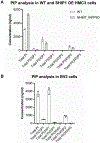SHIP1 modulation and proteome characterization of microglia
- PMID: 38777089
- PMCID: PMC12503353
- DOI: 10.1016/j.jprot.2024.105198
SHIP1 modulation and proteome characterization of microglia
Abstract
Understanding microglial states in the aging brain has become crucial, especially with the discovery of numerous Alzheimer's disease (AD) risk and protective variants in genes such as INPP5D and TREM2, which are essential to microglia function in AD. Here we present a thorough examination of microglia-like cells and primary mouse microglia at the proteome and transcriptome levels to illuminate the roles these genes and the proteins they encode play in various cell states. First, we compared the proteome profiles of wildtype and INPP5D (SHIP1) knockout primary microglia. Our findings revealed significant proteome alterations only in the homozygous SHIP1 knockout, revealing its impact on the microglial proteome. Additionally, we compared the proteome and transcriptome profiles of commonly used in vitro microglia BV2 and HMC3 cells with primary mouse microglia. Our results demonstrated a substantial similarity between the proteome of BV2 and mouse primary cells, while notable differences were observed between BV2 and human HMC3. Lastly, we conducted targeted lipidomic analysis to quantify different phosphatidylinositols (PIs) species, which are direct SHIP1 targets, in the HMC3 and BV2 cells. This in-depth omics analysis of both mouse and human microglia enhances our systematic understanding of these microglia models. SIGNIFICANCE: Given the growing urgency of comprehending microglial function in the context of neurodegenerative diseases and the substantial therapeutic implications associated with SHIP1 modulation, we firmly believe that our study, through a rigorous and comprehensive proteomics, transcriptomics and targeted lipidomic analysis of microglia, contributes to the systematic understanding of microglial function in the context of neurodegenerative diseases.
Keywords: Alzheimer's disease; Microglia; Neurodegeneration; Proteomics; SHIP1; TREM2.
Copyright © 2024. Published by Elsevier B.V.
Conflict of interest statement
Declaration of competing interest E.A., H.H.B., K.D.R., M.J.C, J.A.G. are the employees of Eli Lilly & Company. The remaining authors declare no competing interests or conflict of interest.
Figures




References
-
- INPP5D inositol polyphosphate-5-phosphatase D Nominated Target https://agora.adknowledgeportal.org/genes/(genes-router:gene-details/ENS... (accessed 12/30/2021).
-
- Ubhi K; Masliah E, Alzheimer’s disease: recent advances and future perspectives. J Alzheimers Dis 2013, 33 Suppl 1, S185–94. - PubMed
Publication types
MeSH terms
Substances
Grants and funding
LinkOut - more resources
Full Text Sources
Medical
Molecular Biology Databases

